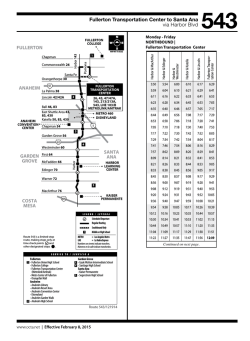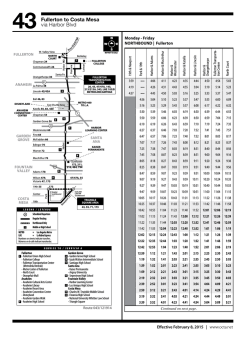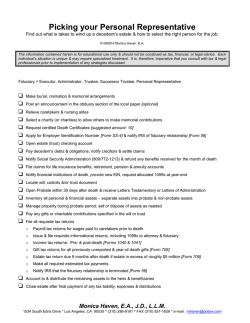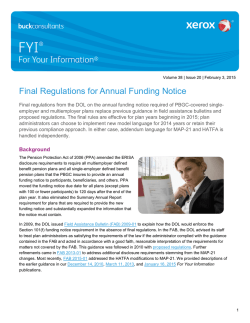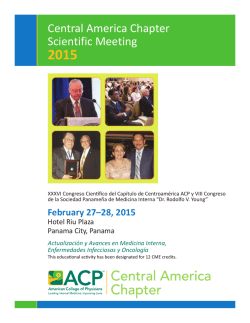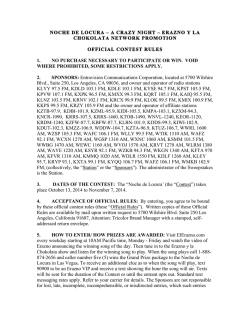
Defined contribution legal and regulatory update
® November 2014 Defined contribution legal and regulatory update. At Putnam, we are committed to providing you with the information and tools you need to meet your fiduciary responsibilities as a plan sponsor and to offer your employees an exceptional retirement plan. This newsletter is designed to inform you about the latest legal and regulatory developments that may affect your plan. IN THIS ISSUE From the Hill .............................................................................................2 New regulatory/legislative issues that plan sponsors should be aware of From the Courts.....................................................................................6 Recent judicial decisions on plan administration and operational issues From Putnam’s Regulatory Services Team ....................... 7 Ideas for improving your plan Key Dates .................................................................................................. 11 And deadlines for 2015 FOR PLAN SPONSOR USE ONLY From the Hill House GOP Tax Reform Initiative Categories of money market funds The amendments establish three broad categories of MMFs: government funds, retail funds, and institutional funds. Government funds are defined as having 99.5% of assets invested in cash or government securities. Retail funds are funds that limit beneficial owners to “natural persons.” Institutional funds are all funds that do not meet the requirements of government or retail funds. Early this year, the Chairman of the House Ways and Means committee, Dave Camp (R-MI), unveiled the Republican tax reform proposal. While it is unlikely that a bill would make it through congress in the near term, the Joint Committee on Taxation (JCT) scored the revenue effects of the proposal. Key retirement provisions include: ny 401(k), 403(b), or 457(b) plan offered by employers with A more than 100 employees would be required to cap pretax deferrals at 50% of the applicable limits (currently $17,500 with an additional $5,500 catch-up contribution for those ages 50 and over). The remaining 50% could only be contributed in the form of a Roth contribution and would be subject to tax. The JCT estimated that this would raise $143.7 billion in revenues over a 10-year period. In a footnote to the amendments, the SEC recognizes that natural persons often invest in money market funds through tax-advantaged trusts, including participant-directed defined contribution plans, IRAs, 403(b) plans, 457 plans, SIMPLE plans, SEPs, and Keoghs. Under this definition, participantdirected 401(k) plans would be eligible to invest in a retail fund. Defined benefit and presumably non-participant-directed defined contribution plans would not meet the natural person definition and would have to invest in either a government fund or an institutional fund. ny inflation adjustments increasing retirement plan conA tribution limits would be frozen for a period of 10 years. This provision would generate $63.4 billion over 10 years. Floating NAV, liquidity fees, and redemption gates Depending on what category an MMF falls into, the amendments impose new requirements on the fund. Institutional funds are required to use a floating NAV and may not take advantage of amortized valuation or penny rounding, but must round to the nearest 1/100th of a percent. Retail and government funds are exempt from the floating NAV requirement. Considerations for plan sponsors As discussed earlier, tax reform is a long-term process, but the fact that provisions were scored does raise the possibility that some of them could be picked up and used as revenue raisers in unrelated legislation. We saw this in early 2013 when an expansion of the ability to make in-plan Roth conversions was used as a revenue raiser for the “fiscal cliff” bill. As always, we will monitor any developments and keep you apprised. Retail and institutional funds may impose liquidity fees or redemption gates should their weekly liquidity levels fall below 30%. Weekly liquidity levels are measured by the percentage of assets invested in cash, U.S. government obligations, or obligations maturing within five business days. Once the weekly liquidity level falls below 30%, the MMF may impose a liquidity redemption fee of up to 2% or impose a redemption gate temporarily suspending redemptions for up to 10 business days. A fund may not impose a gate for more than 10 business days in any 90-day period, and any liquidity fees must be lifted once the fund’s weekly liquidity levels reach 30%. The fund’s board of directors is given discretion to determine whether imposing a liquidity fee or a redemption gate is in the fund’s best interests. SEC Money Market Amendments In late July, the Securities Exchange Commission (SEC) amended the rules governing money market funds (MMFs). Under the existing rules, MMFs were allowed to make use of an amortized cost method of valuation, which essentially smooths the impact of changes in interest rates, and “penny rounding,” allowing rounding to the nearest 1%. During the 2008 market downturn, runs tested MMF liquidity, and one fund “broke the buck,” seeing its NAV fall below $1 per share. The new SEC amendments seek to address these liquidity concerns. 2 Steps for locating missing participants. Regardless of the size of the account, plan sponsors who cannot locate participants using routine methods, such as first class mail or electronic notification, must take all of the following steps before concluding that an individual cannot be located. These steps, outlined in FAB 2014-01, are generally considered low cost with a high potential for success: Should a retail or institutional fund’s weekly liquidity levels fall below 10%, the default is that the fund must impose a liquidity fee of 1%, although once again the fund’s board of directors is given broad discretion in determining whether imposing a fee is in the fund’s best interest or if a different level of fee (not to exceed 2%) is more appropriate. Government funds are not required to impose liquidity fees or redemption gates, but may do so if it is determined to be in the best interest of the fund. 1. Use certified mail. The DOL previously provided a model notice that can be used for such mailings, but use of that specific language is not required. The amendments provide for a two-year transition period for fund companies to comply with the new rules. One challenge facing the companies will be segregating retail investors and institutional investors into separate funds. In addition, there are new disclosure requirements placed on the fund industry with respect to their prospectuses, advertising, and websites. 2.Check related plan and employer records. When the retirement plan records are not current, plan sponsors should check with administrators of related plans, such as medical plans, for a more current address of a missing participant. Due to privacy issues, the plan sponsor may need to request that the other administrator forward a letter on its behalf to the missing participant or beneficiary. Considerations for plan sponsors It is anticipated that the SEC will issue additional guidance as operational concerns are identified. We will be working with industry groups and monitoring the situation closely to keep you up to date on any new developments. 3.Check with the individual’s designated plan beneficiary. Plan fiduciaries should try to identify and contact a missing participant’s designated beneficiary (spouse, children, etc.). If the beneficiary is uncomfortable providing information, the plan fiduciary can request that the beneficiary contact or forward a letter to the missing participant. New DOL Guidance for Locating Missing Participants 4.Use free electronic search tools. Plan fiduciaries should make reasonable use of Internet search tools that do not charge a fee. Such online services include search engines, public record databases (such as those for licenses, mortgages, and real estate taxes), obituaries, and social media. A challenge sometimes faced by plan sponsors is how to locate missing participants. For one reason or another, a plan is still holding benefits for someone, and contact with the individual is lost. This problem is most critical when a plan is terminating and must distribute all benefits, but it is also an issue for an ongoing plan. If these steps do not work, the fiduciary should determine if additional search steps are appropriate. Additional steps might include the use of commercial locator services, credit reporting agencies, information brokers, investigation databases, and other services that may involve charges. In determining whether these additional steps are appropriate, a fiduciary is allowed to take into account the size of the benefit and the amount of the additional expense. The cost of using these methods can be charged to the participant’s account as long as it is reasonable and consistent with the terms of the plan and ERISA’s general fiduciary rules. Recently, the Department of Labor (DOL) updated guidance to its field offices (Field Assistance Bulletin 2014-01) with respect to locating participants when a plan is terminating. However, this guidance also provides a good road map for locating missing participants in an ongoing plan. General concept: Fiduciaries must make reasonable efforts to locate missing participants so that benefits can be distributed to the appropriate parties in a timely fashion. (Note that the term “participant” includes beneficiaries and alternate payees.) 3 DOL Seeks Information About Brokerage Windows Disposing of missing participants’ account balances Generally, once a plan sponsor is satisfied that it has taken appropriate steps to find missing participants, and has documented those efforts, it should review the terms of the plan for direction as to how to treat the participant’s account. Plan documents often provide for the funds in question to be moved to the plan’s designated forfeiture account. If participants later make a claim for benefits, the amount should be restored to their accounts and paid out in accordance with their direction. Under current Department of Labor (DOL) rules, investments selected through a brokerage window are subject to different rules than designated investment alternatives (DIAs) that are selected by a plan fiduciary as part of a plan’s investment menu. For example, participants must receive certain disclosures about brokerage windows, such as how to use them and what the fees are, but they do not need to receive information about investments selected through the window, such as performance or expense ratio data, that is required to be disclosed for DIAs. Similarly, while detailed reporting is required for DIAs on Schedule H to Form 5500, investments through a brokerage window can be lumped together into an “other” category. Finally, and perhaps most importantly, plan fiduciaries have generally understood their responsibilities with regard to brokerage windows to be limited to prudently selecting and monitoring service providers to the brokerage window and providing all required disclosures, but have not understood that liability to extend to monitoring investment decisions made by participants through the window. The DOL makes it clear that applying 100% tax withholding and turning the entire account over to the IRS is not an appropriate method of handling the accounts of missing participants. FAB 2014-01 describes the DOL’s preferred method of disposing of a missing participant’s account in a terminating plan as a rollover to an individual retirement account or annuity (IRA). The DOL offers a safe harbor from fiduciary liability if this approach is used. In reality, it may be hard to find an IRA provider willing to establish an account for a person who cannot be located. Other options the DOL offers for consideration if the IRA approach is not viable for some reason are to establish an interest-bearing, federally insured bank account for the participant, or to transfer the account to a state’s unclaimed property fund. Due to the adverse tax consequences for the participant, these last two options are not the preferred approaches, and fiduciaries must determine if they are prudent to use. The DOL first raised questions about whether current rules on reporting, disclosure, and fiduciary oversight of brokerage window investments were adequate to protect the interests of participants in 2012 in connection with implementation of the participant disclosure rules under ERISA §404a-5. On August 21, 2014, the DOL released a Request for Information (RFI) to help it determine whether, and to what extent, additional regulatory standards or other guidance are needed in order to protect participants in plans that offer a brokerage window. The questions in the RFI cover a wide variety of topics, including: Considerations for plan sponsors The recent DOL guidance specifically applies to terminating plans. Plan fiduciaries should consult with legal counsel as to the appropriateness of applying this guidance to locate missing participants in an ongoing plan. After that determination is made, policies and procedures should be created or reviewed to assist plan fiduciaries in their duties related to locating missing participants. •How they are used: Characteristics of plans and participants using them; what percent of a participant’s account balance is typically invested through the window; what, if any, restrictions typically apply; why plans offer them; demographic data on participants who use them; and whether offering a brokerage window has an impact on the number of DIAs offered. 4 •Outcomes: Whether there is evidence of either good or poor decision-making and outcomes for participants using a brokerage window. Considerations for plan sponsors Responses to the RFI are due by November 19, 2014, and can be submitted to [email protected], referencing “RIN 1210-AB59 – Brokerage Window RFI” in the subject line. After the DOL reviews the comments it receives, it will either seek additional information, determine that no additional regulation is needed, or proceed with a proposed rule or some other form of rulemaking. We will keep you apprised of any developments as they occur. •Selection and monitoring of providers: The DOL is seeking information about how vendors are marketed and selected, whether record keepers offer only an affiliated service or multiple options, what the contractual arrangements are, and what the selection process involves. •Costs: The DOL is interested in understanding what costs are associated with brokerage window investing, whether those costs are borne solely by participants who use them or are spread to other participants, how those costs compare with investing in a DIA, and how plan fiduciaries oversee costs. •The role of advisors: Whether they are typically consulted by plan fiduciaries trying to decide whether to offer a brokerage window and whether they are generally made available to participants investing through a window. •Reporting and disclosure: The DOL is seeking information on what information is currently disclosed to participants and whether additional disclosures would be helpful. It also questions whether Schedule H to Form 5500 should require more information on brokerage window investments. •Monitoring of investments: Whether plan fiduciaries request and receive information about investments made through a brokerage window and whether, and to what extent, they monitor those investments. •Definition: Currently, the different rules regarding reporting, disclosure, and fiduciary oversight apply to brokerage windows and “similar arrangements.” The DOL is questioning whether a more specific definition is needed to distinguish between windows with few or no restrictions on what investments can be accessed through the window and those that offer a limited universe of investments. 5 From the Courts Federal Appeals Court Strengthens ERISA Fiduciary Duty of Prudence Considerations for plan sponsors This case highlights the need for plan fiduciaries to have a strong process in place for investigating and reviewing investments options when making plan decisions. Although this case dealt with decisions related to company stock, the court’s analysis and holding would apply to any fiduciary decision regarding plan investments. Plan sponsors should evaluate their plan investment review and documentation process with their plan advisors to ensure that it is thorough and demonstrates the exercise of procedural prudence. The U.S. Court of Appeals for the Fourth Circuit recently held that a plan fiduciary will be liable for losses caused by breaches of their ERISA fiduciary duty to act prudently unless they are able to show that a fiduciary in a similar situation “would have” made the same decision. Other federal courts have applied a “could have” standard under which a fiduciary would generally not be held liable if another fiduciary in the same situation could have made the same decision. In its decision to apply a “would have” standard, the Fourth Circuit Appeals Court substantially raised the standard under which fiduciary decisions will be reviewed to determine if the fiduciaries are liable for losses caused by fiduciary breaches under ERISA. In this case, the participants in the plan brought a breach of ERISA fiduciary duty claim against the plan fiduciaries alleging that the plan fiduciaries failed to act prudently when they decided to sell company stock held by the plan. The company stock was sold near all-time lows but rose substantially higher months after the sale. The plan participants claimed that the plan fiduciaries failed to engage in a prudent process and conduct a thorough investigation before selling the company stock. The lower court held that although the plan fiduciaries had in fact breached their fiduciary duty to act prudently by not conducting a thorough investigation before selling the stock, the plan fiduciaries were not liable for the loss because the decision was one that a prudent fiduciary “could have” made after performing an investigation. The Appeals Court rejected the lower court’s ruling and held that as the evidence showed that the plan fiduciaries had breached their duty of prudence to the plan, in order to avoid liability for the loss, the fiduciaries must show that a prudent fiduciary in the same situation “would have” made the same decision had they undergone a proper investigation. The case was sent back down to the lower court for a determination of liability based on the “would have” standard. 6 From Putnam’s Regulatory Services Team John Capece, Regulatory Services Manager Merger Considerations for Retirement Plans Terminating a plan prior to an acquisition Another approach may be for the acquired company to terminate its plan prior to the acquisition. A plan termination might then constitute a distributable event for the acquired company’s plan’s participants, giving these participants an opportunity to roll over any eligible funds either to the acquirer’s plan or another retirement vehicle, or to simply take a distribution payable to them. Corporate restructuring can be complex, especially when you need to also give consideration to the retirement plans involved. Too often retirement plans don’t get the attention they need. Taking the time to carefully consider impacts to plans before and during restructuring allows plan sponsors to take advantage of certain opportunities that may not be available later, and to avoid certain pitfalls. Whether the transaction is a corporate merger, spinoff, stock or asset purchase, or the merger of plans, plan sponsors should approach each plan with the same objective — to ensure a smooth transition, clear communication to affected employees, and, of course, protection of the qualified status of the plans. A benefit of this strategy is that the surviving plan sponsor would normally not assume liability or outstanding regulatory issues that may exist with the acquired company’s plan. On the other hand, such a termination would have other legal and administrative impacts like the possible need for 100% vesting and the follow-up needed to pay out all amounts of the prior plan. The best way to accomplish this is through planning and due diligence prior to the close of the transaction. All sides and their respective counsel should give attention to retirement plans from the first discussions of any restructuring. Key questions to consider are: which participants are — and will — be eligible under the new plan structure? Have all protected benefits been identified and preserved? And does the new structure meet all requirements for nondiscrimination and coverage testing? Continuing to maintain separate plans Continuing to maintain each plan separately may be desirable if the sponsor wants the employees of the acquired company to have separate benefits and features than the rest of the employee population (e.g., the acquired company’s employees are part of a collective bargaining agreement). Decisions about how retirement plans will be handled in the context of restructuring are important to get right, which is why we suggest clients get input from their plan counsel. Here are some key subtopics worth considering: However, some separately maintained plans are required to be aggregated for testing and other purposes and there may be additional costs to running more than one plan. Additionally, considerations about employee perceptions are important to consider from a management perspective. Merging two or more plans From a regulatory perspective, the IRS views a plan merger as an amendment to the merging plan to change its existing terms to the terms of the surviving plan. Benefits and features of the plan might change for the merging plan’s existing participants. Under Internal Revenue Code §411(d)(6) (the Anti-cutback Rule), and other applicable rules, these participants may have benefits that must continue to be maintained after the plans are merged. Topics to consider are vesting schedules, withdrawal options, forms of distribution, and crediting of years of service earned prior to the merger. Depending upon the circumstances surrounding a transaction, this option may also serve as an interim solution until a merger can be effectuated. In fact, regulations provide defined contribution plan sponsors with some relief from coverage and related testing requirements during this kind of transition. Regardless of the option chosen, applicable records should be maintained to help memorialize what was decided and why it was in the best interests of the plan participants. Considerations for plan sponsors Your dedicated service team can help identify options, ancillary documents, and processes that will be affected by a potential corporate or plan restructuring. We will work with your ERISA counsel to get a thorough understanding of the Additionally, there are other administrative considerations to incorporate into your decision, such as possibly changing investment options, and educating the incoming participants about the plan they are joining. 7 terms of the transaction and any commitments made with regard to plan benefits. Contact your relationship manager to discuss how we can help you choose the most suitable approach for your particular situation. 401(k) Safe Harbor Plan Design 1. What is the advantage of a §401(k) safe harbor plan? §401(k) plans are required to pass annual nondiscrimination testing on employee elective deferrals (including Roth deferrals, if applicable) and employer matching contributions to ensure that highly compensated employees (HCEs) do not make or receive substantially more contributions than other employees. A plan can avoid this testing if it is designed as a safe harbor plan that satisfies certain requirements. With no testing required under a safe harbor plan, HCEs can defer the maximum amount allowed by law. 2.Which employees are highly compensated? HCEs are generally those employees who earn at least $115,000 (subject to indexing) in the year prior to the year being tested, and employees who own (or are considered to own) more than 5% of the outstanding stock of a corporation (based on value or voting power), or more than 5% of the capital or profits interest of a non-incorporated employer. A plan can limit the number of HCEs to the top 20% of employees based on pay. 3.What are the nondiscrimination tests that a plan can avoid if designed as a safe harbor plan? The actual deferral percentage (ADP) test is used to test employee elective deferrals. The actual contribution percentage (ACP) test is used to test the employer match (and employee after-tax contributions if applicable). A safe harbor plan can avoid both of these tests, but, if employee after-tax contributions are made (not Roth deferrals), then an ACP test will still be needed for the after-tax contributions. Please keep in mind that a safe harbor plan may need to have other tests performed, such as 415 maximum annual addition testing, coverage testing under 410(b), and potentially 401(a)(4) testing if there are different benefit structures. In certain situations, top-heavy testing may not be required if the only contributions to the plan are deferrals, the safe harbor contribution itself, and any matching contribution protected by the safe harbor. 4.What are the required safe harbor contributions an employer must make? The employer must make either a safe harbor match or a safe harbor non-elective contribution, either of which must be fully vested when made. The match must be at least 100% on the first 3% of pay deferred, plus 50% on the next 2% of pay deferred. An enhanced match, such as 100% on the first 4% of pay deferred, is also possible. If the employer would rather make a non-elective contribution, it must be at least 3% of pay. This contribution must be made for all eligible employees, even if they do not defer any of their own pay. The Pension Protection Act (PPA) added another form of a safe harbor plan — the qualified automatic contribution arrangement (QACA). This plan automatically enrolls employees at a minimum of 3% of pay, and increases their deferral rates by one percentage point in each subsequent year until it reaches a minimum of 6% of pay and no more than 10% of pay. The employer safe harbor match under a QACA must be 100% on the first 1% of pay and 50% on the next 5% of pay. A 3% non-elective contribution may be made in lieu of the match. A two-year vesting schedule is allowed in a QACA. 5.Are there special notice requirements associated with a safe harbor plan? Yes, a notice of the plan’s status as a safe harbor plan must be furnished between 30 and 90 days prior to the beginning of the plan year, as well as to newly eligible employees. The notice must describe plan provisions, participant rights and obligations under the plan, the contribution formula, the plan to which safe harbor contributions will be made, the type and amount of compensation that can be deferred, how to make an election and withdrawal, and vesting provisions. A QACA notice must include additional information on the automatic enrollment and automatic increase features of the plan. 6.Can a plan be amended during the plan year to discontinue safe harbor status? With few exceptions, a safe harbor plan cannot be amended during the plan year to modify plan provisions, including the safe harbor status of the plan. This fact may persuade some employers, particularly smaller companies, from establishing a safe harbor plan. There is, however, new flexibility for plans to be amended after the beginning of the plan year to suspend or discontinue safe harbor contributions if certain conditions are satisfied. 8 7. What are the conditions that allow an employer to suspend or discontinue safe harbor contributions? There are now three options for an employer to suspend or reduce safe harbor matching or non-elective contributions after the plan year has begun: you to ensure required notices and other requirements are understood and met. We would also be happy to work with you and your plan counsel so they can provide guidance on this potential plan change. A Timely Reminder Regarding ADP/ACP Testing Option #1 — The safe harbor notice provided to eligible employees prior to the beginning of the plan year must specify that the plan may be amended during the plan year to suspend or reduce the safe harbor contribution. Some in the industry are referring to this as a “Maybe Not” notice. (Some employers will not like the negative message this may send to employees.) As we come toward the close of a plan year, it is always important to make sure that your plan’s actual deferral percentage (ADP) and actual contribution percentage (ACP) testing has been completed. When conducting ADP testing for pretax deferrals/Roth deferrals or ACP testing for matching contributions/traditional employee after-tax (not Roth) contributions, it is important to keep in mind that there is a limited period of time in which refunds can be made if there is a testing failure in order for your plan to remain in compliance. The correction period for a failed ADP/ACP test is defined as the 12-month period following the plan year end that is being tested. For a plan with a December 31, 2013 year end that is being tested, if ADP or ACP testing fails and is being corrected by refunds to the HCEs (highly compensated employees), the refunds must be made by December 31, 2014. As we approach the end of 2014, it is a good time for plan sponsors to double check that their testing has been completed and that refunds, if necessary, have been made in a timely manner. Option #2 — The employer must determine that it is operating at an “economic loss,” although that term is not defined in the regulations. In this situation, it is not necessary that the safe harbor notice contain the “Maybe Not” language required under Option #1, although an amendment to the plan is still required to reduce or discontinue safe harbor contributions. Option #3 — Another option is for a plan to begin the year not as a safe harbor plan, and amend into safe harbor status after the plan year begins. This amendment must be effective at least 30 days before the end of the plan year. A notice must be provided to eligible employees prior to the applicable plan year stating that the plan could be amended to be a safe harbor design using a 3% non-elective contribution (a safe harbor match cannot be used in this particular option). If the plan is in fact amended to become safe harbor, a supplemental notice to employees is required at that time. If no such amendment is made, the plan must use current year testing for its ADP test. Does an excise tax apply to refunds? It depends on when the refunds were made. Refunds must typically be made within 2½ months following the plan year tested to avoid an excise tax being paid to the IRS along with IRS form 5330 being filed with it. For example, a plan that is being tested for the plan year ending December 31, 2014, would need to have refunds made by March 15, 2015 to avoid the excise tax to the IRS. The 10% excise tax is based on the contributions that are refunded (after applying catch-up re-characterization). Please note that for certain EACA (Eligible Automatic Contribution Arrangement) plans that apply auto enrollment to all participants and not just a certain group such as new hires, these plans are granted an extended period of 6 months rather than the typical 2½-month period before an excise tax will apply. (Note: there are various requirements and issues that arise when a plan is amended during the year to reduce or discontinue safe harbor status. Thus, an employer’s legal counsel or advisor should be consulted prior to this action being taken.) Considerations for plan sponsors As with any plan design change, your service team is here to help. We can talk through how this feature may benefit your plan as well as the drawbacks, including reviewing your testing results in recent years and helping you understand the costs of contributions for your particular population. In the event you choose to change your plan, we will further assist 9 Are all plans subject to ADP/ACP testing? No, not all retirement plans are subject to ADP/ACP testing. Some 401(k) plans may have been designed to eliminate ADP and/or ACP testing by having a safe harbor plan feature that allows for the tests to be avoided if certain contribution, vesting, and notice requirements are met. One limitation of the safe harbor design is that if a plan allows for traditional employee after-tax (non-Roth) contributions and an HCE makes such a contribution for the year, then ACP testing will be required even though it has an ACP safe harbor in place. A 403(b) plan does not have ADP testing but if there are matching or traditional after-tax (not Roth) contributions made to the plan, then it will need to have ACP testing performed (it is possible that the 403(b) plan may have a safe harbor design that eliminates the ACP testing on the match). Governmental and 457(b) plans are exempt from both ADP and ACP testing. Considerations for plan sponsors Most testing failures can be corrected without additional penalties to you, if you’re prepared for the testing season. The most important part of being prepared is making sure that you have an efficient process in place for gathering employee data, ensuring that it’s accurate, and providing it to us for testing as soon as possible. The more accurate the data, the more quickly we will be able to perform and analyze your testing results and make recommendations for any necessary corrections, allowing you to avoid the 10% excise tax and other additional contribution obligations that come with the IRS’s correction process. Are refunds the only way to correct a failed test? No, depending upon the plan document, there may be an option to make the test pass by funding additional contributions to the NHCEs (non-highly compensated employees), which can be done by a QNEC (qualified non-elective contribution) or a QMAC (qualified matching contribution). Please note that the QNECs and QMACs are required to be 100% vested and, since they are discretionary in nature, they are not considered safe harbor contributions. Generally, for a plan to use QNECs or QMACs to fix a failed test, the plan would also need to use the current year testing method for its ADP/ACP testing method. What happens if a plan fails ADP and/or ACP testing and a correction is not made within the 12 months following the plan year being tested? The IRS has provisions under its EPCRS (Employee Plans Compliance Resolution) correction program (IRS revenue procedure 2013-12) that specifically addresses this. Essentially, it gives the plan sponsor the choice of either making a QNEC to NHCEs to prevent the ADP and/or ACP test from failing (and no distributions are made to HCEs) or distributions are made to the HCEs and a QNEC is made to the NHCEs for the amount of the refunds made to the HCEs. Either method will require the plan sponsor to fund some level of additional contributions (QNECs) to the NHCEs — obviously one method may be more cost effective than another. At this point, refunds alone are not allowed to correct the ADP/ACP failure. 10 Key Dates And deadlines for 2015 As plan sponsors kick off the New Year, the following are general guidelines on key dates and deadlines to keep in mind. Of course, not all plans run on the same schedules (e.g., “off-calendar” plans, plans with features that allow for extension of some dates), but this guide provides an overview to help you plan strategies for 2015. If you have any questions about the applicability of the dates below to your plans, do not hesitate to contact your relationship manager. JANUARY 31, 2015 • Deadline for providing all testing data, in order for us to guarantee testing is complete by March 15, 2014. • Final date by which we will have mailed IRS Forms 1099R to all plan participants who received a distribution during 2014. JANUARY – MARCH 13, 2015 • By March 13, plan sponsors should have completed yearly compliance testing (e.g., ADP/ACP) and any required returns. If you haven’t heard from us about year-end testing for 2014, please call at your earliest convenience. • Refunds that may result from testing failures are not required to be completed prior to March 13; however, if they are completed later, a 10% excise tax may apply. Any required returns related to 2014 need to be completed by the end of 2015. (Note that this deadline may be extended from March 13 to June 30 for certain types of Automatic Enrollment Plans.) FIRST QUARTER, 2015 • Plan sponsors can apply any remaining ERISA account funds accumulated in 2014. We can assist you by providing you with the amount available for use. JULY 29, 2015 • F or plan sponsors who have made changes during 2014 to their retirement plans, this is generally the latest date by which a new Summary Plan Description or Summary of Material Modification is due to your plan participants. In most cases, this will have already been completed before this date but to ensure compliance, we recommend you consider whether there have been material changes to your plan during 2014 that need to be communicated to participants. JULY 31, 2015 • Filing deadline for 2014 Form 5500 and related schedules. While this deadline is only applicable to calendaryear plans, and extensions are available in many instances, sponsors should keep this date in mind and contact their relationship manager if they are unsure of the date for their respective plans to file. Late filing could result in fines and other penalties. SEPTEMBER 30, 2015 •D eadline for delivery of Summary Annual Report of the plan to plan participants. Note that this deadline only applies to those calendar year plans that have not requested a deadline extension via IRS Form 5558. OCTOBER 15, 2015 • For calendar year plans for which an extension applies for purposes of Form 5500, this is generally the latest date to file. DECEMBER 1, 2015 • Deadline for participant notices to be provided for safe harbor and certain automatic enrollment plans. DECEMBER 31, 2015 • By this date, plan sponsors of calendar year plans should generally have allocated or otherwise utilized all forfeiture dollars in their plans that relate to 2014 or earlier activity. Most commonly, forfeitures are used to pay plan expenses and/or as additional contributions or to reduce employer costs for contributions otherwise being made to the plan. Check your plan document or contact your relationship manager if you are unsure how your plan treats forfeitures. 11 ® Benefit from our experience Putnam is committed to the retirement services industry, and has a history of advocacy built on over 75 years of experience. Expect a premium level of service Putnam has a 40-year history of providing superior service to our clients in the retirement industry. Realize the value of innovation Putnam continuously works to improve the plan sponsor and employee experience. See individual, measurable results Our personalized experience has proven to be effective at driving increased savings. For more information, visit putnam.com/dcio One Post Office Square Boston, MA 02109 FOR PLAN SPONSOR USE Putnam Retail Management 1-800-719-9914 DC704 291985 11/14 12 putnam.com
© Copyright 2026
